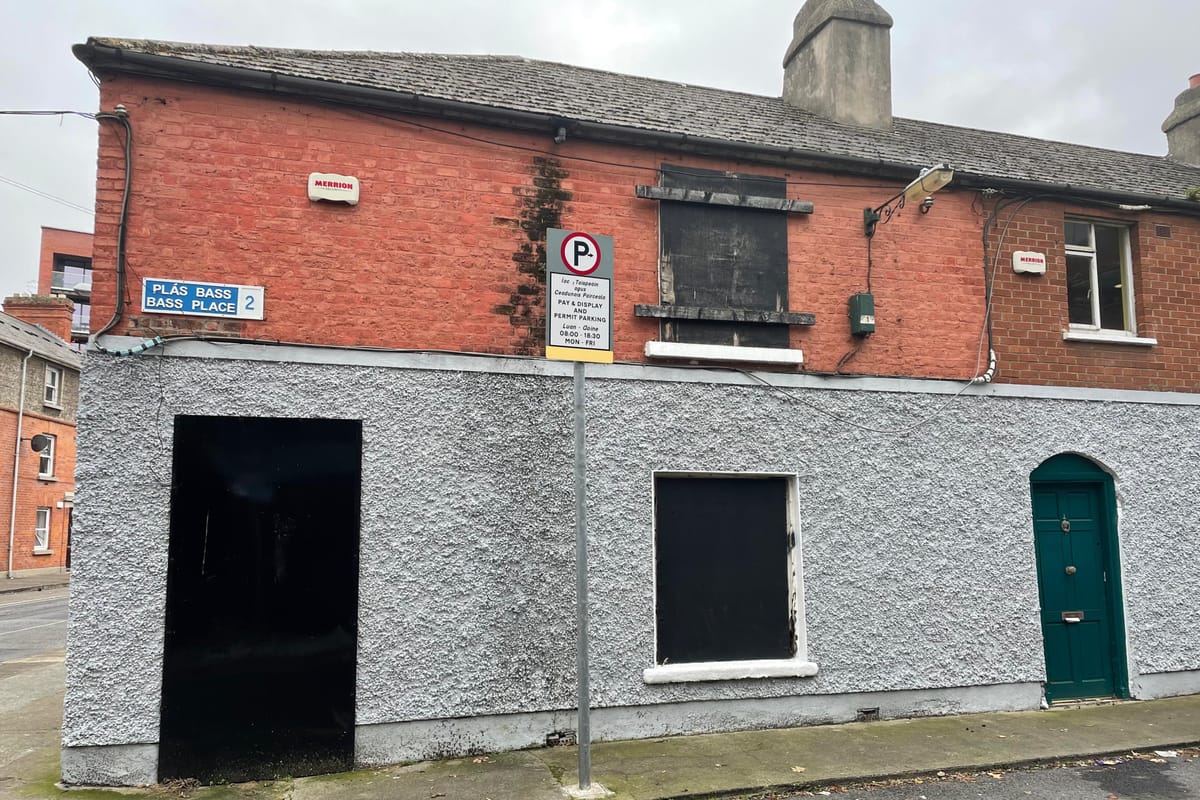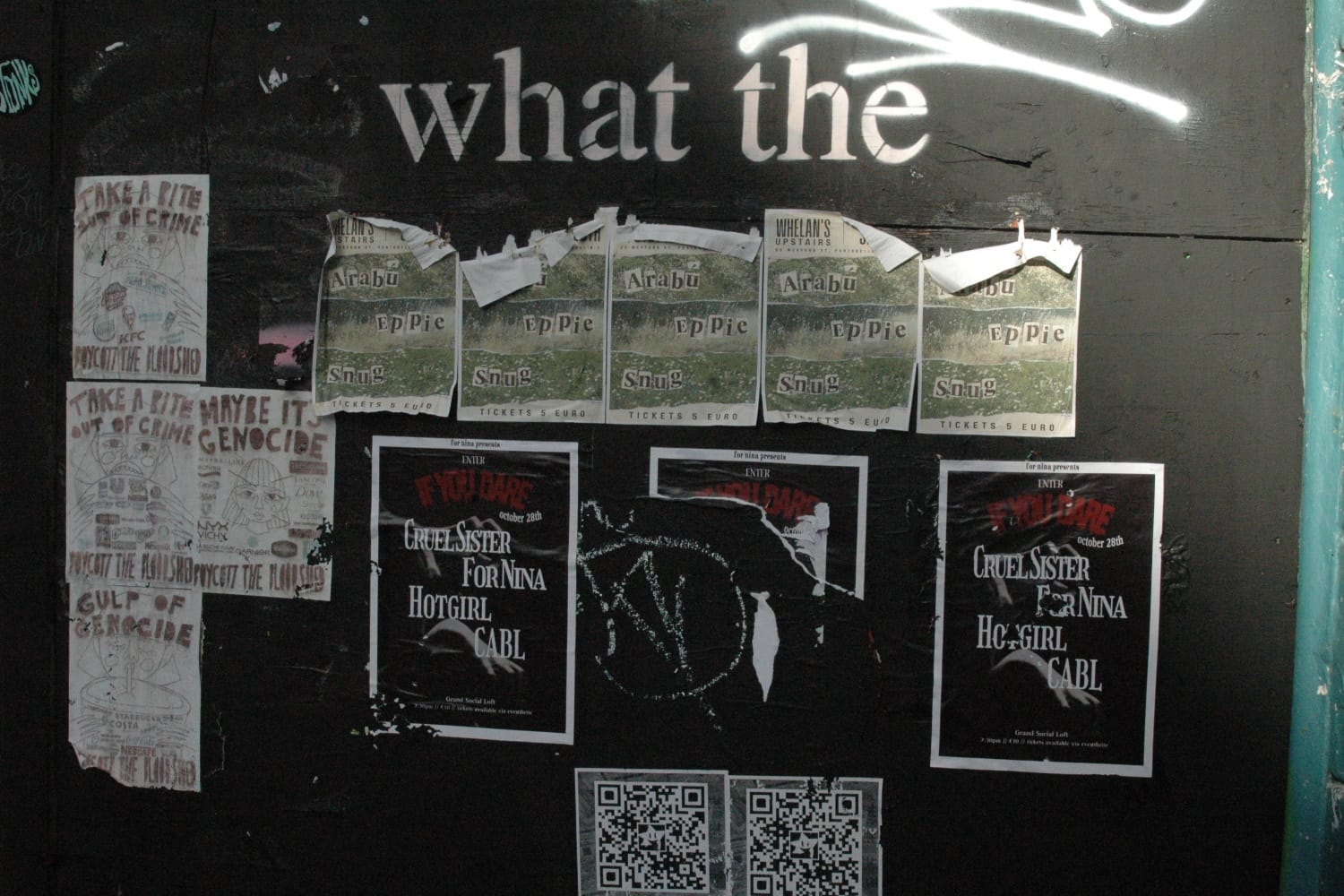Years after promise of a new integration strategy, Dublin City Council still doesn’t have one
There’s a desperate need for a roadmap to improve efforts to help people navigate immigrant life, and connect, say councillors and community workers.
Because of its central location, the high footfall in the area, and its proximity to a lot of venues and cultural spaces, it’s become a premier flyering spot.

A few weeds sprout through the cracks at the bottom of the blue hoardings outside numbers 54 and 55 South William Street.
Temporary barriers conceal the ground floors of the two properties almost entirely, with only the peeling paint and empty windows of the upper storeys visible.
Still, there were a few small holes around the corners and edges of the wooden panels which enabled passers-by to glimpse behind them and see what looks like a miniature forest on the front steps.
These are protected structures in the bustling inner-city, said independent Councillor Mannix Flynn on Tuesday morning. “And that hoarding has been there for seven years, I’d imagine.”
The two properties are owned by Aviva Irish Property Fund, and they do have plans to eventually redevelop them, a spokesperson for Aviva Life and Pensions Ireland DAC said on Tuesday.
But, in the absence of any usage in recent years, the hoardings, like the thicket of weeds and ferns behind them, have taken on a life of their own, steadily becoming a local noticeboard for gigs, events and the occasional political cause.
More recently, over the summer, the street artist known as Decoy decorated it with a mural depicting five different coloured heads wearing baseball caps, and each with their legs emerging from where their necks and the rest of their bodies ought to be.
But by this past Sunday, the mural was starting to get covered again bit-by-but in posters, promoting upcoming gigs, clubnights and a few slots on Dublin Digital Radio.
Because of its central location, the high footfall in the area, and its proximity to a lot of venues and cultural spaces, it’s become one of the premier flyering spots in the city centre, says artist John O’Flynn. “The people there are the people going to our shows.”
Vacancy is a prominent issue in the city, and particularly so around the South William Street area, says Andrea Horan, the owner of Topical Popical, the nearby nail salon.
Whether it’s intentional or not, covering the hoardings outside empty properties with murals and flyers is a way of reclaiming a part of the city, she says. “And what we’re seeing here is artists responding to stuff like that. They’re pushed out of the city centre, students are pushed out.”
There’s less of a sense that the city belongs to young people, she says. “When the takeover of these hoardings happen, I feel like it is people’s grasp to kind of have some sort of ownership of place within the city.”
Both 54 and 55 South William Street are listed as protected structures, with the latter’s construction dated to the 1770s, according to the National Built Heritage Service website.
In February 2015, Clonmida Limited applied to Dublin City Council to change the use of 55 from wholesale use to a cafe and office spaces.
It was at that time a vacant space, which had formerly been used as a drapes shop, the planning application says. Although images on Google Street View show the company, French Dressings Ltd hadn’t operated out of that space since 2009 at the earliest.
The council granted Clonmida Limited permission. However, the planning site notes that Clonmida was in receivership, and in 2018, an application to amend the previous permission was submitted by Friends First Life Assurance Co.
In August 2018, Friends First Life Assurance Co. also applied to the council, seeking an exemption for carrying out refurbishment works on numbers 53 and 54, due to their being protected structures.
During that same period, images on Google Street View show that the hoardings went up outside 55, advertising that the space was available to let as a cafe or restaurant.
Then, in July 2019, the council granted Friends First permission to redevelop 54 and 55 together as a cafe or restaurant.
Hoardings covered both properties by September 2019, images on Google Street View show, and they have yet to come down.
But the properties changed hands. Sort of.
Friends First Life Assurance Co was acquired by Aviva Life and Pensions in June 2018, an Aviva press release from March 2019 says.
And both 54 and 55 are now under the ownership of Aviva, a spokesperson for the insurance company said on Tuesday. “Aviva can also confirm that it is currently developing plans for the future redevelopment of these buildings.”
Although when asked to specify what these plans might be, the spokesperson did not comment.
But the lack of purpose for these buildings for several years now, and the imposing presence of the hoardings outside them was raised recently at a meeting of the council’s South East Area Committee.
Those hoardings were making the area seem dilapidated, said Flynn, the independent councillor, at the meeting on 13 October. “It’s outrageous.”
John MacEvilly, a council area manager, said he would contact the council’s roadworks team to find out why the hoardings have been there so long. But Flynn had yet to hear anything, he said, by phone on Tuesday.
The site isn’t included on the council’s derelict sites register, he says. The Derelict Sites Act says a derelict site is one that brings down the neighbourhood because it’s in such bad shape, or dangerous, or neglected, or unsightly, or covered in rubbish.
“A simple hoarding on a revered street has been lying there over the past seven years,” Flynn said. The council isn’t being proactive about these things, he said.
A spokesperson for the council has not responded to a query sent Monday asking why neither of these properties was listed on the derelict register. And whether it has been investigated as an active file.
But councillors and officials did recently agree to a new, more aggressive process for tackling dereliction and vacancy in the city – a shift that is complicated slightly by the fact that the council also says it has paused any compulsory purchase orders.

While the two properties became lifeless, the hoarding gained a second life as a place to announce events.
Initially, the hoardings were used to advertise that the space was up for letting to businesses seeking to run a cafe or restaurant, according to Google Street View images from 2019.
But, two years later, images show it attracted a few bits of graffiti, like a Banksy-esque poster of a hooded figure, a blue stenciled message by the graffiti artist Oriel saying “Garda: Not just a sex symbol”, and a minimalist blue and white poster by the artist Magnus Mudrack.
It was just a place to put up work, Mudrack said, writing via Instagram on Monday. “It is unlikely to annoy anyone and if it does it won’t bother them too much.”
There wasn’t much more to it than that, he said.
Then, the posters started to appear. Sometimes, the whole wooden structure was covered by the same gig announcement. By 2024, images on Google Street View show it advertising everything from clubnights to exhibitions.

It was a good location for anything culture-related, as the footfall was definitely the target demographic, more often than not, says the painter John O’Flynn who used it to advertise his debut solo exhibition, For What It’s Worth. “The demographic is generally people going to these shows.”
Generally, the best places are those where a poster is unlikely to get ripped down, he says. “Temporary structures, hoardings, they’re good. Anything that is Dublin City Council-based, they tend to get taken down quite quickly.”
He stuck his up particularly high, he says. “It’s because I want it to stand out.”
But there’s generally an unwritten rule that you don’t cover over someone else’s poster until the event is done, says Diolmhain Ingram Roche, the lead vocalist for the band Really Good Time. “You’re trying to be respectful. There’s something kinda sweet in it being this informal thing everyone shares.”
Really Good Time put their first poster up in late 2023 to advertise a headline gig in the Sound House, he says. “We did it the first time where we were promoting a gig ourselves, so we put a bunch of them up, and put one there.”
Somehow, a year later, the poster was still there, faded but largely intact, he says. And for a November 2024 gig in Whelans, they printed up a pair of particularly large posters specifically for the hoardings, reading “The Greatest Band On Earth?”
Because the gig was a big deal, they wanted a “loud statement”, he said. “They were supposed to perfectly fit the panels, but we measured them incorrectly. So they didn’t quite fit.”
It wasn’t a deliberate act of reclaiming space, consciously at least, he said. “The first priority was about selling tickets.”
But, the feeling of being squeezed out of the city has become a large part of the experience of being an artist in Dublin, he says. “Because of that reality, you have to make do and make the best of it.”